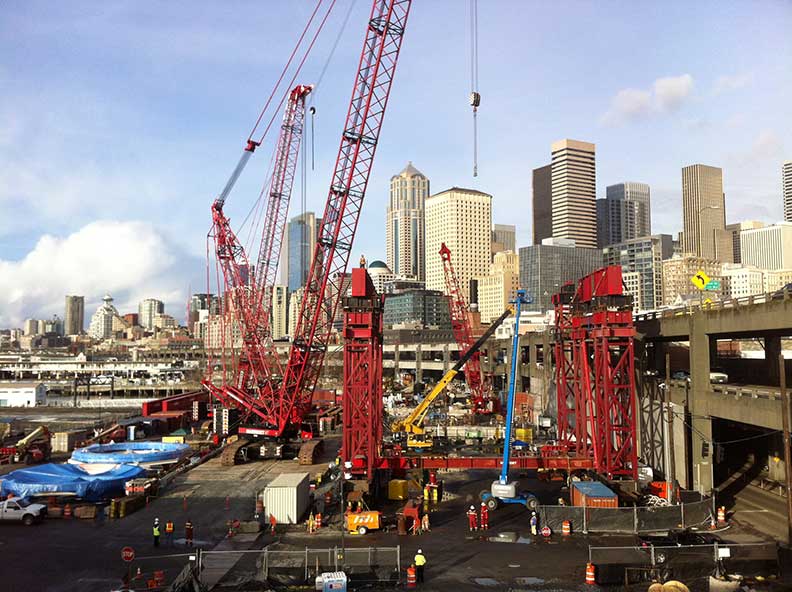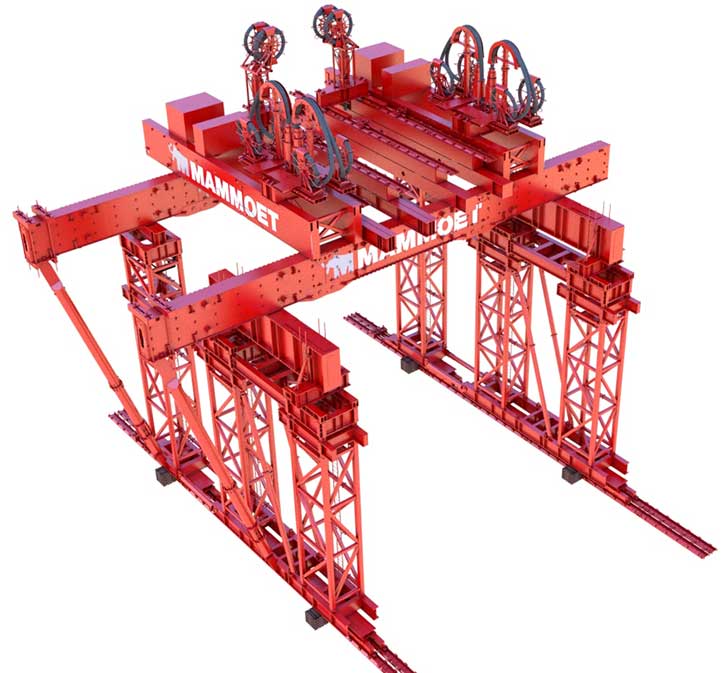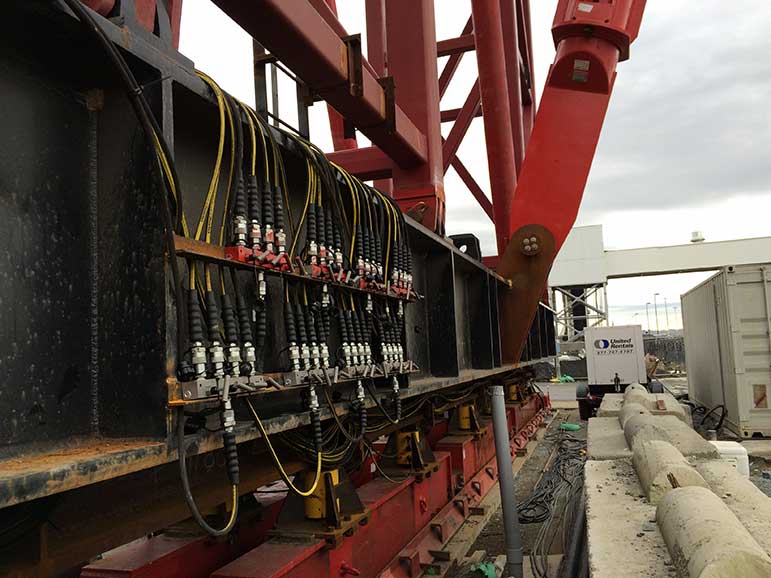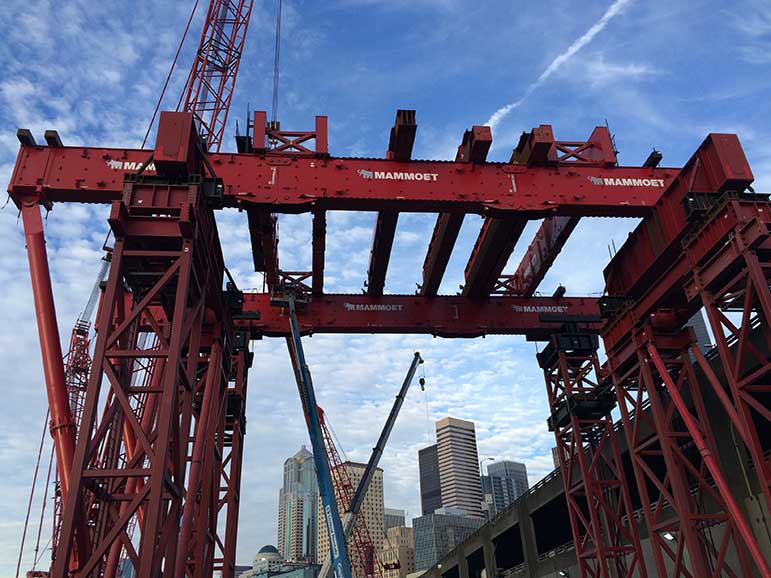Unique gantry for mega-TBM lift 12 March 2015
Nearly 16 months after the world’s largest TBM was forced to shut down after suffering power loss, damage to its seal assembly, and suspected main bearing damage, Seattle Tunnel Partners - the construction joint venture of Dragados and Tutor Perini – expects, finally, to begin the complex process of lifting the 17.5m diameter machine from its current resting place at the bottom of the 120ft recovery shaft.
Inside the Hitachi-Zosen manufactured TBM, crews are disconnecting hoses and cables, and have already removed eight of the 24 motors. Removing these will give crews the clearance they need to lift the cutterhead and drive unit to the surface. The remaining 16 motors, which each weigh approximately 8,000lbs (3,630kg), will remain attached and be removed from the pit as part of the cutterhead lift. A crawler crane will remove smaller pieces of the machine in advance of the gantry crane being moved into position to lift the 2,000 tonne cutterhead and drive unit.
To achieve the major lifts specialist hoisting company Mammoet has been subcontacted to design and install the enormous gantry required to carry out the operation.
“The gantry is what makes this operation unique. It has been tailor made just for hoisting Bertha,” said Mammoet Project Manager Jeroen van Kooperen. After Mammoet was awarded the recovery contract in the summer of 2014, the company designed the 32m high gantry inside four weeks.
However, another subcontractor in charge of the gantry’s foundations discovered afterwards that these would not be strong enough to hold the gantry. “A firm breeze and horizontal forces during the hoist could lead to unwanted torque in the foundation,” Van Kooperen explained. “Detailed calculations showed us the foundations could not bear these lateral forces.”
The gantry foundation is comprised of two concrete beams, 1.5m wide and 1.8m deep. These beams are cast on both sides of Bertha's recovery shaft, on top of concrete piles. The gantry is constructed to a width of 22.7m, equal to that of the distance between the concrete pile walls that STP had constructed on either side of the tunnel alignment at the start of the project to control settlement and protect the existing viaduct.
Of course no one ever imagined a 1,300 tonne gantry would need to rest on top of these sheet piles. “It would have been a difficult task to subsequently strengthen the existing concrete piles just to keep the gantry from subsiding, or to construct a foundation on top of them that could withstand the torque,” said Van Kooperen. “A less time consuming option, and above all a less expensive one, was our proposition for adjusting the gantry. We decided to rest it entirely on 48 hydraulic cylinders to eliminate the torque. As far as we know this is the first time ever a gantry of this size has rested entirely on hydraulic platforms.”
On the bottom of each side of the gantry six so-called skid beams are mounted, each with a length of 4.7m. On top of these beams sits a double rail track that has been constructed to enable positioning during the hoist. However, the lateral forces would be expected to create an uneven pressure distribution on the skid beams, leading to the torque-effect in the underlying foundations.
“We installed four pressure cylinders on each pair of skid beams, two at the front and two at the back,” explained Van Kooperen. “By connecting these cylinders to each other, the hydraulic fluid inside them will level and therefore so too will the fluid pressure during a lateral load.” Fluid will flow from the heavier loaded cylinder to the lesser loaded one. Because the cylinders have the same area on both sides, a mechanical equilibrium forms in the middle of the foundation.
A quarter turn
The lift itself, when it begins, will be a high-precision operation. With a cutterhead diameter of 17.5m this only leaves clearance of 2.25m on either side of the recovery shaft wall. After Mammoet has removed the outer shell using a 600 tonne crane, it will then hoist the 2,000 tonne drive unit. “In order to control the horizontal movements during the hoist we have placed anchors at ten points divided over the shaft wall, said Van Kooperen". Each anchor will hold a lifting eye, to which Mammoet will attach a hydraulic pulling chain. The other side of each chain will be attached to the cutterhead itself. These chains are only meant for controlling the horizontal movement.”
Six strand jacks connected to a pulley will be used to hoist the cutterhead. Each of these 900 tonne hydraulic hoist cylinders contains 54 steel cables, 20mm in diameter. “With this system we can generate considerable hoisting power using relatively small sized cylinders,” said Van Kooperen. The system comprises four main hoist cylinders, two on each side. The last two cylinders are mounted on a skid track on top of the gantry. Mammoet will use these two cylinders to turn the cutterhead by a quarter turn, in mid-air, so that it can be lowered to the repair frame at ground level.
During an operation such as this operational safety is critical. To this end, the hydraulic pulling chains can be operated from distance, meaning that not a single construction worker will have to stand underneath the heavy load during the hoist. “Safety is our top priority,” said Van Kooperen. “We will not take any risks. Each of our systems and every operation will be analysed thoroughly.”
The reverse operation - reinstating the new bearing and bearing seal ring on the cutter driving unit – will present even more of a precision challenge for Mammoet. “The bearing seal ring has a diameter of 14m and a very tight fit of only 0.5mm,” said Van Kooperen. “For this step we have made special slings which again contain hydraulic cylinders. These equalise the load on the seal, which will prevent it from deforming.”
After the repairs are carried out by Hitachi engineers on the surface, Mammoet will go through every step again, but this time backwards, to get Bertha back in the ground. If everything goes according to plan, the damaged seals will be replaced in May (2015) for a revised resumption of tunneling in August following completion of testing and assuming no further complications.
References
- Bertha ready for disassembly and repair – TunnelTalk, March 2015
- Bertha begins final drive into recovery shaft – TunnelTalk, February 2015
- Technical assistance for TBM Bertha repair – TunnelTalk, February 2015
|
|
|
|
|
Add your comment
- Thank you for taking the time to share your thoughts and comments. You share in the wider tunnelling community, so please keep your comments smart and civil. Don't attack other readers personally, and keep your language professional.




